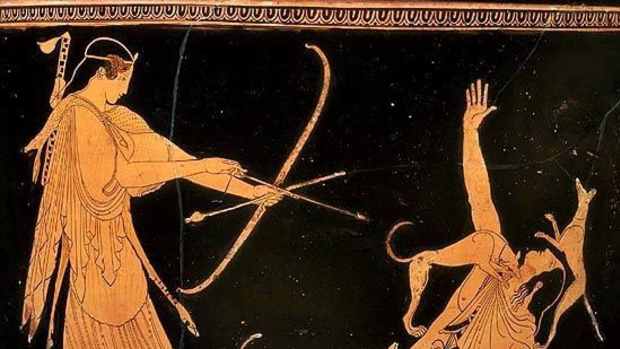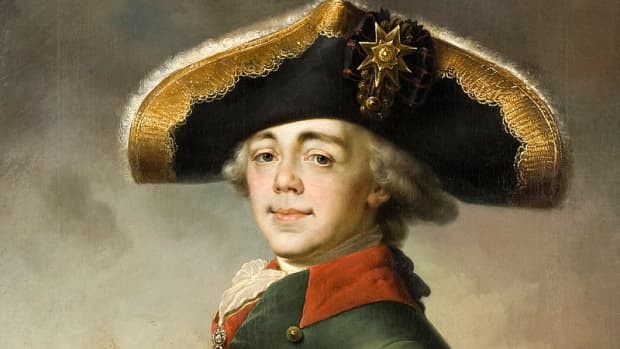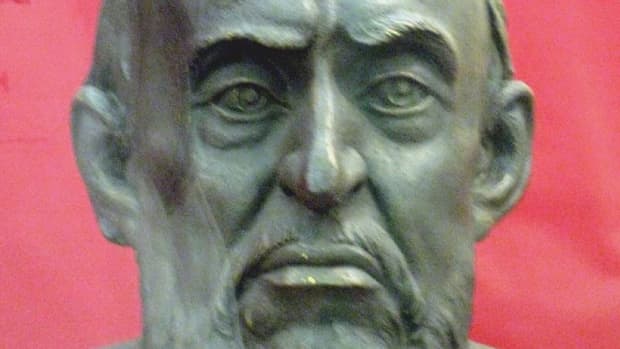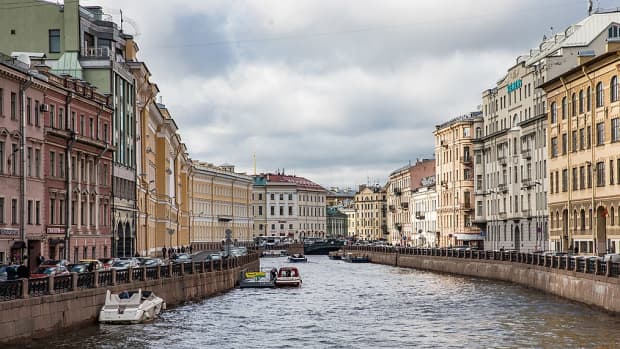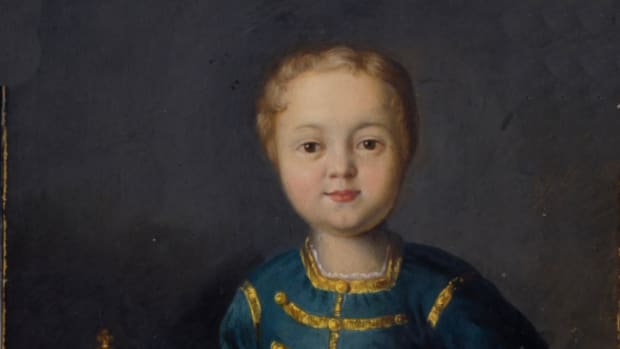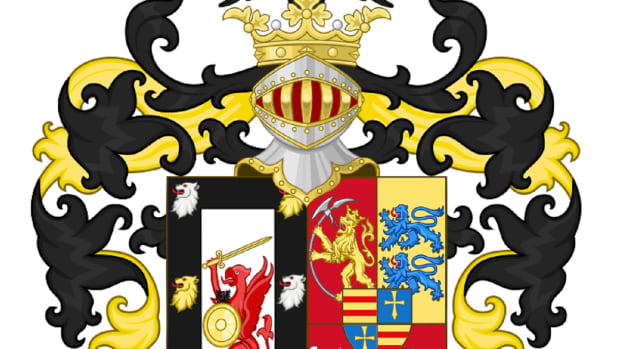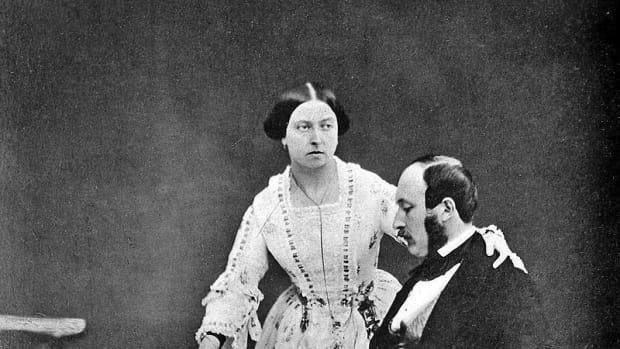The Assassination of Tsar Paul I of Russia: 23rd March 1801
Paul Romanov or Paul Saltykov?
Paul I, Tsar of All Russia was born in St. Petersburg on 1st October 1754. He was the son of Catherine the Great, born Princess Sophie of Anhalt-Zerbst in Prussia, and Peter III, Tsar of All Russia for a few months in 1762. Catherine called Peter, her second cousin, a "child-husband" and an "idiot".
Peter's aunt Empress Elizabeth took control of Paul's upbringing and she removed him from Peter and Catherine's court at Oranienbaum, west of St. Petersburg and they rarely saw him.
Paul's true paternity has always been questioned. Catherine claimed later in her life that she and Peter never consummated their marriage. Peter III acknowledged Paul as his son and when a short-lived daughter named Anna Petrovna was born in 1759, she was accepted as a Romanov. Peter and Catherine indulged in affairs during their marriage. It's possible that Count Sergei Vasilievich Saltykov was Paul's father.
If the count was his father, which we'll never know, then Paul was not a Romanov but a Saltykov-Anhalt-Zerbst and so when he came to the throne the Romanov dynasty's era ended, genetically at least.

Tsar Paul I's parents. Peter III was overthrown in a coup, probably masterminded by his wife who proclaimed herself Catherine II, better known as Catherine the Great.
Wikipedia Public Domain
Catherine II Succeeds Ousted Peter III
Paul was intelligent but rash, and like Peter III he was obsessed with the military. Throughout his life he loved uniforms and parades. His governor was Nikita Ivanovich Panin. Panin's nephew was one of Paul's assassins in 1801.
On 5th January 1762 Empress Elisabeth died and Peter became the tsar. Paul, now the tsarevich, openly criticised his father's policies.
In July 1762, Catherine took advantage of a coup to overthrow her troublesome husband (she probably arranged the coup). She declared herself Empress Catherine II. She had the support of the aristocracy and the military.
Peter was imprisoned and he died in unclear circumstances on 17th July 1762, aged 34. He was buried without the usual ceremony afforded to a tsar.
Empress Catherine and Paul never grew close. She sent him to his private estate in Gatchina. He derided and dismissed her decisions from afar.
Paul married Wilhemine of Hesse-Darmstadt in 1773 and she took the name Natalia Alexeievna. Natalia and their child died in childbirth. Paul married again less than 6 months later, as his mother commanded. Sophie Dorothea of Wurttemberg took the name Maria Feodorovna and she bore 10 children, 9 survived into adulthood including Tsar Alexander I.
Catherine the Great died on 17th November 1796. The new tsar was unprepared for his role.

German General Levi August von Bennigsen plotted the coup to overthrow Paul I.
Wikipedia Public Domain
Recommended
Tsar Paul I: Autocrat and Despot
Tsar Paul I was a keen autocrat and he made unpopular changes to laws, taxes and the military. For Paul, freedom of thought and liberal politics were forbidden concepts. His vindictiveness, hardline foreign policies and a frustrating unpredictable manner alienated his formerly faithful followers. As early as autumn 1797 rumours about plots to overthrow despotic Paul circulated.
There were hundreds of conspirators. One plot would be realised; a coup was planned by Count Nikolai Alexandrovich Zubov, General Levin August von Bennigsen, Admiral Jose de Ribas, Count Peter Ludwig van Pahlen and Count Nikita Petrovich Panin. It's highly unlikely that Paul's wife or his heir Alexander were unaware of the plot. In all likelihood, Alexander sanctioned a bloodless coup.
Paul became increasingly paranoid. He sensed danger and none of his existing palaces made him feel safe. He commissioned the Mikhailovsky Palace in St. Petersburg so that he could feel confident and protected. He and his family moved in on 1st February 1801. He evidently didn't think he had enemies within the palace walls.

Count Nikolai Alexandrovich Zubov was one of the leaders of the coup against Paul I.
Wikipedia Public Domain
The Assassination of Tsar Paul I
At approximately 1.20 a.m. on 23rd March 1801, Zubov, Bennigsen, Panin and van dr Pahlen and 10 soldiers broke into Paul's bedroom at the Mikhailovsky Palace. (Admiral de Ribas died prior to the event). They saw an empty bed, felt that it was still warm and they discovered Paul hiding behind a decorative screen.
He was pulled towards a desk where he was presented with a document to sign, for his immediate abdication. Paul was unwilling. Zubov cut him with his sword to persuade him to reconsider.
Paul resisted. He was strangled and trampled to death. His bruised and bloodied body was worked on by physicians and the court painter so that it looked as if he died of natural causes. His official cause of death was an "apoplexy stroke".
As the public filed past his coffin before his burial no one suspected foul play. They had little opportunity. One witness claimed that he passed the coffin 10 times, that he was urged to be quick by soldiers, and that he only glimpsed a tricorn hat low over Paul's face and the soles of his boots.

The Mikhailovsky Palace, St. Petersburg. Tsar Paul I was assassinated here on 23rd March 1801.
Wikipedia/A. Savin FAL
Tsar Alexander I Reverses Paul I's Decrees
Paul's eldest son Alexander became Tsar Alexander I. He probably didn't know that his father was destined to die that March night. Perhaps the main conspirators didn't either. He wept for his father when he learned that he was dead; Zubov ordered him to claim his birthright and rule instead of crying.
On Alexander's first day in power he pardoned 12,000 people that Paul had imprisoned without trials during his reign. He was much more liberally minded than his father. He reigned until his death from typhus on 1st December 1825.

Alexander I, Tsar of All Russia succeeded his father in 1801. He was aware of the coup to overthrow Paul I.
Wikipedia Public Domain
Sources
- The Murder of Tsar Paul I | History Today
- Paul | Biography & Facts | Britannica
- Assassination of Paul I, Emperor of All Russia (1801) | Unofficial Royalty
This content is accurate and true to the best of the author’s knowledge and is not meant to substitute for formal and individualized advice from a qualified professional.
© 2024 Joanne Hayle


